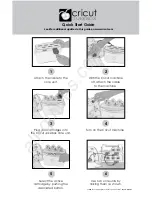
Manual, F/T Sensor, Ethernet Axia
Document #9620-05-C-Ethernet Axia-02
Pinnacle Park • 1031 Goodworth Drive • Apex, NC 27539 • Tel:+1 919.772.0115 • Fax:+1 919.772.8259 •
C-7
Glossary
Term
Definitions
Active Configuration
The configuration that the system is currently using.
ADC
Analog-to-digital converter
Bias
Biasing is useful for eliminating the effects of gravity (tool weight) or other acting
forces. When the bias function is used, the software collects data for the forces and
torques that are currently acting on the sensor and use these readings as a reference
for future readings. Future readings will have this reference subtracted from them
before they are transmitted. Bias may also be referred to as “zero out” or “tare”
the sensor.
Calibration
Defines a specific measurement or sensing range for a given sensor. Calibration is
also the act of measuring a transducer’s raw response to loads and creating data
used in converting the response to forces and torques.
CGI
Common Gateway Interface (CGI) is the method of using web URLs to communicate
data and parameters back to a web device.
Complex Loading
Any force or torque load that is not purely in one axis.
Configuration
User-defined settings that include which force and torque units are reported and
which calibration is to be used.
Control Panel
A feature on a personal computer operating system where a user can adjust
system settings.
Coordinate Frame
See Sensor Reference Frame Origin.
Data Rate
How fast data can be output over the network.
DHCP
Dynamic Host Configuration Protocol (DHCP) is an automatic method for Ethernet
equipment to obtain an IP address. The Ethernet Axia system can obtain its IP
address using DHCP on networks that support this protocol.
DINT
Signed double integer (32 bit)
ENABL
Boolean that uses Enabled to represent 1 and Disabled to represent 0
Ethernet
A family of computer networking technologies commonly used in local area networks.
Fieldbus
A generic term referring to any one of a number of industrial computer networking
standards. Examples include: Ethernet, CAN, Modbus, and PROFINET.
FT or F/T
Force and Torque.
F
xy
The resultant force vector comprised of components F
x
and F
y
.
Force
A force is a push or pull action on an object caused by an interaction with another
object. Force = mass X acceleration
HEX
n
Hexadecimal number of
n
bits, prefixed with 0x
HTTP GET Method
A standard and common method that a user can request data from a specified
resource such as a sensor. HTTP works as a request-response protocol between
client (web browser) and server (the sensor).
Hysteresis
A source of measurement error caused by the residual effects of
previously applied loads.
INT
Signed integer (16 bit)
Interface Plate
A separate plate that attaches the sensor to another surface. Interface plates are
often used if the bolt pattern on the sensor doesn’t match the bolt pattern on the
robot arm or customer tooling. The interface plate has two bolt patterns, one on either
side of the plate. One side is for the sensor. The other side is for the robot arm or
customer tooling.
IP64
Ingress protection rating “64” designates protection against dust and splashing of
water. An IP64 rating does not guarantee protection when a user submerges a device
in water or any type of fluid.
IP67
Ingress protection rating “67” designates protection against dust and submersion
under 1 m of fresh water.








































